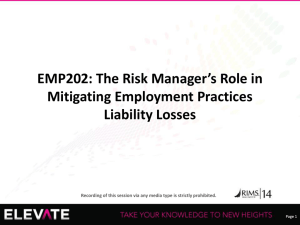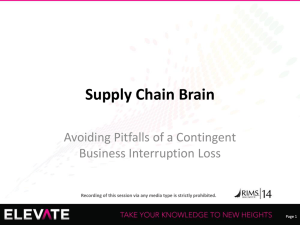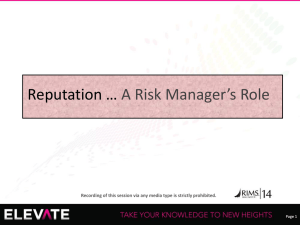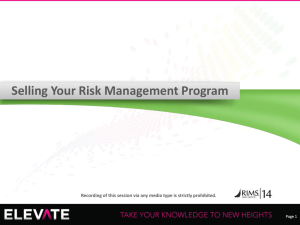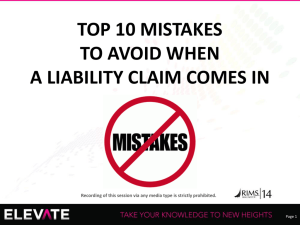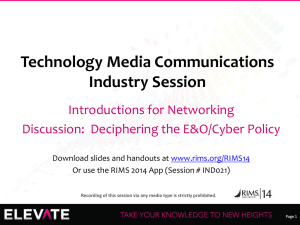Predictive Models
advertisement
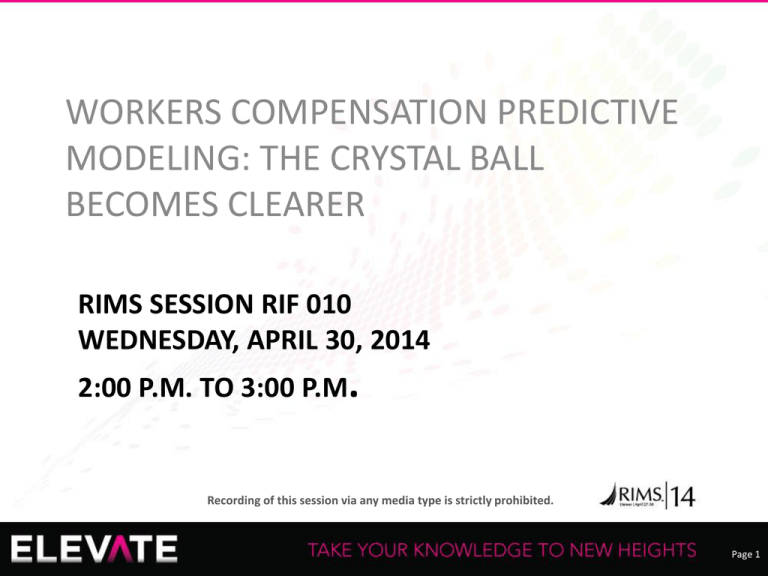
WORKERS COMPENSATION PREDICTIVE MODELING: THE CRYSTAL BALL BECOMES CLEARER RIMS SESSION RIF 010 WEDNESDAY, APRIL 30, 2014 2:00 P.M. TO 3:00 P.M. Recording of this session via any media type is strictly prohibited. Page 1 TODAY’S PRESENTERS Melissa Bowman-Miller, Staffmark David Duden, Deloitte Sean Martin, Travelers Jeff Branca, Marsh Recording of this session via any media type is strictly prohibited. Page 2 Today’s Agenda Introductions & Housekeeping Defining Predictive Modeling Risk Manager’s Perspective Insurer’s Viewpoint Consultant – Bridging the Gap Questions & Discussion Recording of this session via any media type is strictly prohibited. Page 3 What Differentiates Claims Organizations? “If we want to make better decisions and take the right actions, we have to use analytics. Putting analytics to work is about improving performance in key business domains using data and analysis.” - Tom Davenport, author of Analytics at Work: Smarter Decisions, Better Results 5-10% Can create new algorithms Analytical semiprofessionals 15-20% Can use visual and basic statistical tools, create simple predictive models Analytical amateurs 70-80% Can use spreadsheets and use analytical transactions Insight Analytical professionals True Claims Predictive Modeling Hindsight Lead analytical initiatives 1% Foresight Analytical champions Recording of this session via any media type is strictly prohibited. Page 4 PM Helps Organizations Target High Exposure Claims When a claimant’s injury is a sprained back, there is a wide and varying distribution of claim outcomes The worst 20 - 30% of claims contribute to 70 - 80% of loss costs PM uses a variety of data sources and analytics techniques to enable organizations to predict which claims are most likely to be the worst claims The graph below shows the varying distribution in total lost days for back sprain injuries 40% Injury: Back Sprain Pct of Total Losses 35% 30% 25% 20% 15% 10% 5% 0% 1 2 3 4 5 6 7 8 9 Recording of this session via any media type is strictly prohibited. 10 Page 5 Traditional and Non-traditional Characteristics Can Be Predictive Insights can be revealed through both traditional and non-traditional risk characteristics. Even use of a relatively small set of predictive variables can enhance claim segmentation. 100% Relative claim severity 80% Claimant Age 60% 40% 20% 0% -20% -40% -60% -80% < 25 25-30 30-35 35-40 40-45 45-50 50-55 55-60 60-65 65+ 40% Relative claim severity 30% Distance: Claimant Home and Employer 20% 10% 0% -10% -20% -30% -40% Recording of this session via any media type is strictly prohibited. <1 1 to 3 3 to 5 5 to 7 7 to 10 10 to 15 15 to 20 20 to 25 25 to 30 30+ Page 6 Data From Traditional and Non-traditional Means Used to Predict Outcomes By combining internal data with external data from a number of sources, enhanced segmentation can be achieved. External data can also provide an early indication of existing co-morbidities. Claimant Data Medical Data External Public Databases • Claimant Specific Information • Zip Code Demographic • Medical History • Household Demographic • Treatment History • Diagnosis Information • Claimant • Treating Physician • Years of Employment • Medical • Diagnosis Information • Type of Work • Legal • Treatment Patterns • Job Level • Prescription Usage • Average Weekly Wage • Co-morbidities Claims Data Employer Data Policy History Data • Losses • Experience Data • Financial Stress • Timing/Patterns • Policy Data • Years in Business • Settlement Data • Public Record Filings • Jurisdiction • Loss Control Data • Fraud/Lawsuit Recording of this session via any media type is strictly prohibited. Page 7 Clients Are Realizing Significant Benefits From Our Claims Predictive Models Workers’ compensation models for claim operations are designed to help injured claimants return to work sooner, with reduce loss costs. Claim Routing & Assignment Fraud Detection Right claim, right resource Reduce lag time of SIU referrals Improve routing to auto-adjudication Improve mix of claims referred to SIU Increase triage consistency through automation Deterrence of “soft-fraud” Projected Business Impact 4-8% reduction in loss and expense 5-10% improvement in SIU managed claims Typical Range of Savings for Clients WC Spend 4% – 8% $100M Medical Management Prompt assignment of nurses on those cases that need it most Integrate behavior issues into nurse assignment Cost effective use of field case management 20-25% redeployment of supervisory resources 3-7% improvement in nurse managed claims Savings Per $100M Of WC Spend $4M $8M Top Line Growth Demonstrated ability to close claims faster and cheaper leads to competitive market advantage Improved client satisfaction strengthens the relationship and brand Recording of this session via any media type is strictly prohibited. Page 8 RISK MANAGER’S VIEW Recording of this session via any media type is strictly prohibited. Page 9 Why Predictive Analytics? Workers’ Compensation! Will you be my miracle? • Always been metrics focused o Track losses monthly by Business Unit/Branch/Customer – Avg. cost per claim, Loss Rate, Frequency Annual Workers’ Compensation Actuarial Reserve Analysis o Quarterly Roll-Forwards estimating Ultimates o Annual estimates of Pure Premiums (Loss Rates) o Recording of this session via any media type is strictly prohibited. Page 10 “Early Intervention Is the Next Best Thing to Prevention” The power to see the future! If we knew from the start which claims were going to become complex and costly we would: - Assign the claim to the appropriate level adjuster - Increase Management review and involvement - Involve appropriate medical cost control measures - Retain the best legal defense - Focus on Return-to-Work Shout-out to the hard-working Adjuster • • Not a replacement Tool to help manage claims and reduce workload Recording of this session via any media type is strictly prohibited. Page 11 Data Ex Machina How can predictive analytics be used? …Let me count the ways… Through Scoring (i.e., High (red zone) to Low (green zone)) and action items can provide guidance on: - Claim prioritization - Expedition of low exposure claims - Proper assignment of claims to appropriate level adjuster - Cost effective use of field case management - Loss Reserving - Settlements - Future Allowable estimates (Medicare and Rx Risk) - Subrogation potential - Litigation management - Fraud detection (better utilization of Investigative resources) Recording of this session via any media type is strictly prohibited. Page 12 A Predictive Model Enables Multiple Business Applications Predictive models prospectively identify adverse claims to enable proactive management strategies across all areas of a claim to drive better business results. Maintain Value Proposition Optimize Claim Outcomes Deliver high quality service Connect to customers and agents Ensure quality medical care Pay the right amount Ensure appropriate return to work for all injured workers Accelerate the claims life cycle Minimize Costs to Handle Improve process and operational efficiency Properly match skills with work Maintain Discipline Improve reserve accuracy and consistency Enhance regulatory and corporate compliance Drive to Excellence Leadership vision and commitment Organizational readiness to execute Claim Assignment SIU Mgmt. Escalation Medical Case Mgmt. Subrogation Litigation Recording of this session via any media type is strictly prohibited. Page 13 Other Uses of Predictive Analytics Review of Client/Location Performance Loss Ratio/Frequency Rate by Industry Average (WC Code/State) Tracking locals with higher Loss Ratios Pricing (Lost Cost prediction) Underwriting (Risk Selection and Triggers to ask additional information) Recording of this session via any media type is strictly prohibited. Page 14 INSURER PERSPECTIVE Recording of this session via any media type is strictly prohibited. Page 15 Workers’ Compensation 1 Indemnity Indemnity Indemnity 53% 41% Medicals 47% 1989 Medicals 33% 59% 2011p Medicals 67% 2019 Estimate 1 Top five states only, normalized by state; includes medical only and indemnity claims. Accident Year evaluated at 24 months. As reported in NCCI State of the Line Report. 2019 Data: Insurance Information Institute Recording of this session via any media type is strictly prohibited. Page 16 Recording of this session via any media type is strictly prohibited. Page 17 Data & Analytics: Predictive Models Early Identification & Intervention The right resources on the right claims at the right time Recording of this session via any media type is strictly prohibited. Page 18 Predictive Models Used on All New Claims Nurse Triage which determines the need for nurse case management Return-to-work Target Dates model identifies expedient and safe return-towork expectations Subrogation Triage model helps us ensure that we pursue every opportunity for recovery Risk Control Triage model helps determine if it would be beneficial to bring in risk control expertise to help mitigate future, similar risks 67% of injured workers return to work within 30 days with our RTW focus* *Return To Work: National Accounts book of Recording of this session via any media type is strictly prohibited. business results for accident year 2012. Page 19 Models Used During the Life of the Claim Early Intervention Chronic Pain model which helps us manage chronic pain from the beginning of an injury Recidivism model to intervene in claims where re-injury could threaten permanent return-to-work Pharmacy Intervention model targets specific high-risk medications and drug interactions which can harm return-to-work efforts Environmental Scans help us identify and alert claim professionals to state specific variations in the claim handling process Recording of this session via any media type is strictly prohibited. Page 20 Evolving Structured Unstructured Other Factors Strategic Claim File Review Selection Recording of this session via any media type is strictly prohibited. Page 21 Discussion Recording of this session via any media type is strictly prohibited. Page 22 Thank You for Participating Recording of this session via any media type is strictly prohibited. Page 23

